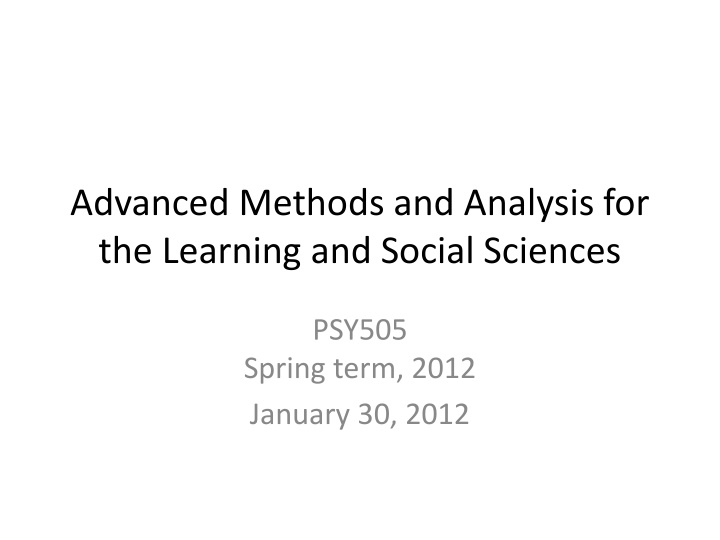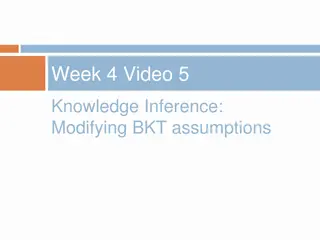
Bayesian Knowledge Tracing: Methods and Analysis in Learning Sciences
Explore the differences between Bayesian Knowledge Tracing (BKT) and other assessment models like PFA and IRT. Learn about the assumptions, typical usage, and key concepts of BKT in assessing students' knowledge in educational settings.
Uploaded on | 0 Views
Download Presentation

Please find below an Image/Link to download the presentation.
The content on the website is provided AS IS for your information and personal use only. It may not be sold, licensed, or shared on other websites without obtaining consent from the author. If you encounter any issues during the download, it is possible that the publisher has removed the file from their server.
You are allowed to download the files provided on this website for personal or commercial use, subject to the condition that they are used lawfully. All files are the property of their respective owners.
The content on the website is provided AS IS for your information and personal use only. It may not be sold, licensed, or shared on other websites without obtaining consent from the author.
E N D
Presentation Transcript
Advanced Methods and Analysis for the Learning and Social Sciences PSY505 Spring term, 2012 January 30, 2012
Todays Class Bayesian Knowledge Tracing
How does BKT differ from PFA? Assesses latent knowledge as well as probability of correctness Only handles one skill per item (extensions can handle this)
How does BKT differ from IRT? Takes learning into account Ignores item-level differences in difficulty
What is the typical use of BKT? Assess a student s knowledge of topic X Based on a sequence of items that are dichotomously scored E.g. the student can get a score of 0 or 1 on each item Where each item corresponds to a single skill Where the student can learn on each item, due to help, feedback, scaffolding, etc.
Key assumptions Each item must involve a single latent trait or skill Different from PFA Each skill has four parameters From these parameters, and the pattern of successes and failures the student has had on each relevant skill so far, we can compute latent knowledge P(Ln) and the probability P(CORR) that the learner will get the item correct
Key Assumptions Two-state learning model Each skill is either learned or unlearned In problem-solving, the student can learn a skill at each opportunity to apply the skill A student does not forget a skill, once he or she knows it
Model Performance Assumptions If the student knows a skill, there is still some chance the student will slip and make a mistake. If the student does not know a skill, there is still some chance the student will guess correctly.
Corbett and Andersons Model p(T) Not learned Learned p(L0) p(G) 1-p(S) correct correct Two Learning Parameters p(L0) problem solving. Probability the skill is already known before the first opportunity to use the skill in p(T) Probability the skill will be learned at each opportunity to use the skill. Two Performance Parameters p(G) Probability the student will guess correctly if the skill is not known. p(S) Probability the student will slip (make a mistake) if the skill is known.
Bayesian Knowledge Tracing Whenever the student has an opportunity to use a skill, the probability that the student knows the skill is updated using formulas derived from Bayes Theorem.
BKT Only uses first problem attempt on each item (just like PFA) What are the advantages and disadvantages? Note that several variants to BKT break this assumption at least in part more on that later
Knowledge Tracing How do we know if a knowledge tracing model is any good? Our primary goal is to predict knowledge
Knowledge Tracing How do we know if a knowledge tracing model is any good? Our primary goal is to predict knowledge But knowledge is a latent trait
Knowledge Tracing How do we know if a knowledge tracing model is any good? Our primary goal is to predict knowledge But knowledge is a latent trait But we can check those knowledge predictions by checking how well the model predicts performance
Fitting a Knowledge-Tracing Model In principle, any set of four parameters can be used by knowledge-tracing But parameters that predict student performance better are preferred
Knowledge Tracing So, we pick the knowledge tracing parameters that best predict performance Defined as whether a student s action will be correct or wrong at a given time
Fit Methods There are many fit methods Before we go into them in detail, let s discuss the homework solutions
Sweets BKT Solution Sweet, can you please talk us through your spreadsheet? Also, tell us (but no need to show us) how you computed the parameter values
Zaks BKT Solution Zak got the exact same parameter values as Sweet did Zak, why did this happen?
Goodness Zak PFA 12,122.77 Sweet PFA 10,896.09 Sweet BKT 8140.995 Zak BKT 8140.995 (dummy values) (fit in Matlab)
Thoughts? Why might BKT have worked better than PFA?
Excel issues Several folks had Excel crashing issues on this assignment Anyone want to discuss the problems you had? We can discuss how to fix them
Fit Methods Hill-Climbing Hill-Climbing (Randomized Restart) Iterative Gradient Descent (and variants) Expectation Maximization (and variants) Brute Force/Grid Search
Hill-Climbing The simplest space search algorithm Start from some choice of parameter values Try moving some parameter value in either direction by some amount If the model gets better, keep moving in the same direction by the same amount until it stops getting better Then you can try moving by a smaller amount If the model gets worse, try the opposite direction
Hill-Climbing Vulnerable to Local Minima a point in the data space where no move makes your model better but there is some other point in the data space that *is* better Unclear if this is a problem for BKT IGD (which is a variant on hill-climbing) typically does worse than Brute Force (Baker et al., 2008) Pardos et al. (2010) did not find evidence for local minima (but with simulated data)
Lets try Hill-Climbing On assignment data set For one skill Let s use 0.1 as the starting point for all four parameters
Hill-Climbing with Randomized Restart One way of addressing local minima is to run the algorithms with randomly selected different initial parameter values
Lets try Hill-Climbing On assignment data set For one skill Let s run four times with different randomly selected parameters
Iterative Gradient Descent Find which set of parameters and step size (may be different for different parameters) leads to the best improvement Use that set of parameters and step size Repeat
Conjugate Gradient Descent Variant of Iterative Gradient Descent (used by Albert Corbett and Excel) Rather complex to explain I assume that you have taken a first course in linear algebra, and that you have a solid understanding of matrix multiplication and linear independence J.G. Shewchuk, An Introduction to the Conjugate Gradient Method Without the Agonizing Pain. (p. 5 of 58)
Expectation Maximization (Thanks to Joe Beck for explaining this to me) 1. Starts with initial values for L0, T, G, S 2. Estimates student knowledge P(Ln) at each problem step 3. Estimates L0, T, G, S using student knowledge estimates 4. If goodness is substantially different from last time it was estimated, and max iterations has not been reached, go to step 2
Expectation Maximization EM is vulnerable to local minima just like hill- climbing and gradient descent Randomized restart typically used
Lets try Expectation Maximization By hand in Excel Log likelihood is typically used, but for ease of real-time calculation we will use SSR
Brute Force/Grid Search Try all combination of values at a 0.01 grain-size: L0=0, T=0, G= 0, S=0 L0=0.01, T=0, G= 0, S=0 L0=0.02, T=0, G= 0, S=0 L0=1,T=0,G=0,S=0 L0=1,T=1,G=0.3,S=0.3 I ll explain this soon
Which is best? EM better than CGD Chang et al., 2006 CGD better than EM Baker et al., 2008 A = 0.05 A = 0.01 EM better than BF Pavlik et al., 2009 Gong et al., 2010 Pardos et al., 2011 Gowda et al., 2011 BF better than EM Pavlik et al., 2009 Baker et al., 2011 A = 0.003, A = 0.01 A = 0.005 RMSE= 0.005 A = 0.02 A = 0.01, A = 0.005 A = 0.001 BF better than CGD Baker et al., 2010 A = 0.02
Maybe a slight advantage for EM The differences are tiny
Model Degeneracy (Baker, Corbett, & Aleven, 2008)
Conceptual Idea Behind Knowledge Tracing Knowing a skill generally leads to correct performance Correct performance implies that a student knows the relevant skill Hence, by looking at whether a student s performance is correct, we can infer whether they know the skill
Essentially A knowledge model is degenerate when it violates this idea When knowing a skill leads to worse performance When getting a skill wrong means you know it
Theoretical Degeneracy P(S)>0.5 A student who knows a skill is more likely to get a wrong answer than a correct answer P(G)>0.5 A student who does not know a skill is more likely to get a correct answer than a wrong answer
Empirical Degeneracy Actual behavior by a model that violates the link between knowledge and performance
Empirical Degeneracy: Test 1 (Concrete Version) (Abstract version given in paper) If a student s first 3 actions in the tutor are correct The model s estimated probability that the student knows the skill Should be higher than before these 3 actions.
Test 1 Passed P(L0)= 0.2 Bob gets his first three actions right P(L3)= 0.4
Test 1 Failed P(L0)= 0.2 Maria gets her first three actions right P(L3)= 0.1
Empirical Degeneracy: Test 2 (Concrete Version) (Abstract version in paper) If the student makes 10 correct responses in a row The model should assess that the student has mastered the skill

